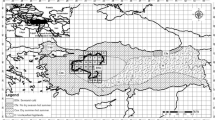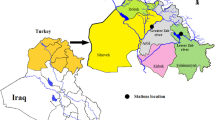Abstract
Drought is below-normal availability of rainfall, runoff, and or soil moisture for a prolonged period in a given region. Modeling drought index using multiple variables is important for future hydrological drought monitoring and sustainable water resource management. This study aimed to model multivariate standardized drought index (MSDI) based on the drought information from precipitation and runoff. Long year (1980–2014) monthly observed precipitation and runoff data were used to analyzed standardized precipitation index (SPI) and standardized runoff index (SRI) respectively. The best-fit copula family was selected to construct the joint probability distribution (JPD) of the SPI and SRI, and MSDI was developed. SPI, SRI, and MSDI at 6 and 12-month drought time scales were analyzed to characterize hydrological drought properties. The correlation among three drought indices (SPI, SRI, and MSDI) were analyzed using the Pearson correlation method. The goodness-of-fit test result showed that the Clayton copula was found the best-fitted copula function in describing JPD the two drought indices. The MSDI showed that the drought onset most likely similar to the SPI. Moreover, MSDI showed the maximum duration of drought occurred with varying severities about 26–28-months, while the duration of drought is extensive, but the frequency of drought less relative to SPI and SRI. The developed model, MSDI had a high correlation with SPI and SRI \((R>0.7 \mathrm\,\text{and}\,{R}^{2}>0.5, p \sim 0.0)\) compared to the correlation between SPI and SRI. Therefore, modeling hydrological drought using multiple variables is better than estimated with a single variable.






Similar content being viewed by others
Data availability
Data will be made available on request.
References
Abramowitz, M., Stegun, I.A (1965) Handbook of mathematical functions: with formulas, graphs, and mathematical tables 55 (Courier Corporation). 3rd ed. National Bureau of Standards Applied Mathematics Series, Washington, DC
Aho K, Derryberry D, Peterson T (2014) Model selection for ecologists: the worldviews of AIC and BIC. Ecology 95:631–636. https://doi.org/10.1890/13-1452.1
Akaike H (1974) A new look at the statistical model identification. Sel. Pap.s Hirotugu Akaike. Springer, Berlin, pp 215–222
Belayneh A, Adamowski J, Khalil B, Ozga-Zielinski B (2014) Long-term SPI drought forecasting in the Awash River Basin in Ethiopia using wavelet neural network and wavelet support vector regression models. J Hydrol 508:418–429
Bisht DS, Sridhar V, Mishra A, Chatterjee C, Raghuwanshi NS (2019) Drought characterization over India under projected climate scenario. Int J Climatol 39:1889–1911. https://doi.org/10.1002/joc.5922
Dai A, Zhao T, Chen J (2018) Climate change and drought: a precipitation and evaporation perspective. Curr Clim Chang Rep 4:301–312. https://doi.org/10.1007/s40641-018-0101-6
Dash SS, Sahoo B, Raghuwanshi NS (2019) A SWAT-Copula based approach for monitoring and assessment of drought propagation in an irrigation command. Ecol Eng 127:417–430. https://doi.org/10.1016/j.ecoleng.2018.11.021
Edossa DC, Babel MS, Das GA (2010) Drought analysis in the Awash river basin, Ethiopia. Water Resour Manag 24:1441–1460. https://doi.org/10.1007/s11269-009-9508-0
Edwards DC (1997) Characteristics of 20th Century drought in the United States at multiple time scales. Air Force Inst of Tech Wright-Patterson AFB OH. https://hdl.handle.net/10217/170176
FAO (1998) Division F and AO of the UNL and WD. The soil and terrain database for Northeastern Africa: crop production system zones of the IGAD subregion. FAO, Rome
Favre A, El Adlouni S, Perreault L, Thiémonge N, Bobée B (2004) Multivariate hydrological frequency analysis using copulas. Water Resour Res. https://doi.org/10.1029/2003WR002456
Gebrehiwot T, van der Veen A, Maathuis B (2011) Spatial and temporal assessment of drought in the Northern highlands of Ethiopia. Int J Appl Earth Obs Geoinf 13:309–321. https://doi.org/10.1016/j.jag.2010.12.002
Gidey E, Dikinya O, Sebego R, Segosebe E, Zenebe A (2018) Predictions of future meteorological drought hazard (~ 2070) under the representative concentration path (RCP) 4.5 climate change scenarios in Raya. North Ethiop Model Earth Syst Environ 4:475–488. https://doi.org/10.1007/s40808-018-0453-x
Haile GG, Tang Q, Li W, Liu X, Drought ZX (2020) Progress in broadening its understanding. Wiley Interdiscip Rev Water 7:e1407. https://doi.org/10.1002/wat2.1407
Hao Z, AghaKouchak A (2013) Multivariate standardized drought index: a parametric multi-index model. Adv Water Resour 57:12–18. https://doi.org/10.1016/j.advwatres.2013.03.009
Hastings C (1955) Approximations for digital computers. University Princeton, Princeton
Heim RR Jr (2002) A review of twentieth-century drought indices used in the United States. Bull Am Meteorol Soc 83:1149–1166. https://doi.org/10.1175/1520-0477-83.8.1149
Kebede A, Raju UJP, Korecha D, Nigussie M (2020) Developing new drought indices with and without climate signal information over the Upper Blue Nile. Model Earth Syst Environ 6:151–161. https://doi.org/10.1007/s40808-019-00667-y
Krause J, Schütt B, Thiemann S (2004) Landscape characterstics of a Drainage Basin in the Southern Ethiopia Rift Valley. In: 1st Ethiopia Proceedings Sedimentary Studies in Tropics and subtropics. Siegen, Germany.
Kwon M, Kwon H, Han D (2019) Spatio-temporal drought patterns of multiple drought indices based on precipitation and soil moisture: a case study in South Korea. Int J Climatol 39:4669–4687. https://doi.org/10.1002/joc.6094
McKee TB, Doesken NJ, Kleist J (1993) The relationship of drought frequency and duration to time scales. In: Proceedings of 8th Conference on Applied Climatology, American Meteorological Society Boston, MA, pp. 179–83.
Mishra SS, Nagarajan R (2011) Drought assessment in Tel watershed: an integrated approach using run analysis and SPI. IEEE Earthzine 1:8
Mishra AK, Singh VP (2010) A review of drought concepts. J Hydrol 391:202–216. https://doi.org/10.1016/j.jhydrol.2010.07.012
Mo KC (2011) Drought onset and recovery over the United States. J Geophys Res Atmos. https://doi.org/10.1029/2011JD016168
Mukherjee S, Mishra A, Trenberth KE (2018) Climate change and drought: a perspective on drought indices. Curr Clim Chang Rep 4:145–163. https://doi.org/10.1007/s40641-018-0098-x
Nam W-H, Hayes MJ, Svoboda MD, Tadesse T, Wilhite DA (2015) Drought hazard assessment in the context of climate change for South Korea. Agric Water Manag 160:106–117. https://doi.org/10.1016/j.agwat.2015.06.029
Ndehedehe CE, Awange JL, Corner RJ, Kuhn M, Okwuashi O (2016) On the potentials of multiple climate variables in assessing the spatio-temporal characteristics of hydrological droughts over the Volta Basin. Sci Total Environ 557:819–837. https://doi.org/10.1016/j.scitotenv.2016.03.004
Pathak AA, Dodamani BM (2020) Trend analysis of rainfall, rainy days and drought: a case study of Ghataprabha River Basin, India. Model Earth Syst Environ 6:1–16. https://doi.org/10.1007/s40808-020-00798-7
Patterson LA, Lutz BD, Doyle MW (2013) Characterization of drought in the south Atlantic, United States. JAWRA J Am Water Resour Assoc 49:1385–1397. https://doi.org/10.1111/jawr.12090
Sadegh M, Ragno E, AghaKouchak A (2017) Multivariate C opula A nalysis T oolbox (MvCAT): describing dependence and underlying uncertainty using a B ayesian framework. Water Resour Res 53:5166–5183
Saravi MM, Safdari AA, Malekian A (2009) Intensity-duration-frequency and spatial analysis of droughts using the standardized precipitation index. Hydrol Earth Syst Sci Discuss 6:1347–1383. https://doi.org/10.5194/hessd-6-1347-2009
Schwarz G (1978) Estimating the dimension of a model. Ann Stat 6:461–464
Sirdaş S, Sen Z (2003) Spatio-temporal drought analysis in the Trakya region, Turkey. Hydrol Sci J 48:809–820
Sklar M (1959) Fonctions de repartition an dimensions et leurs marges. Publ Inst Stat Univ Paris 8:229–231
Sobhani B, Zengir VS (2020) Modeling, monitoring and forecasting of drought in south and southwestern Iran. Iran Model Earth Syst Environ 6:63–71. https://doi.org/10.1007/s40808-019-00655-2
Sobhani B, Zengir VS, Kianian MK (2019) Drought monitoring in the Lake Urmia basin in Iran. Arab J Geosci 12:448. https://doi.org/10.1007/s12517-019-4571-1
Supriya P, Krishnaveni M, Subbulakshmi M (2015) Regression analysis of annual maximum daily rainfall and stream flow for flood forecasting in Vellar River Basin. Aquat Proced 4:957–963. https://doi.org/10.1016/j.aqpro.2015.02.120
Teklemariam A (2005) Water quality monitoring in Lake Abaya and Lake Chamo region: a research based on water resources of the Abaya-Chamo Basin-South Ethiopia. University of Siegen
Thom HCS (1951) A frequency distribution for precipitation. Bull Am Meteorol Soc 32:397
Thom HCS (1966) Some Methods of Climatological Analysis. WMO Technical Note Number 81, Secretariat of the World Meteorological Organization, Geneva, p 53
Van Loon AF (2015) Hydrological drought explained. Wiley Interdiscip Rev Water 2:359–392. https://doi.org/10.1002/wat2.1085
Vicente-Serrano SM (2006) Differences in spatial patterns of drought on different time scales: an analysis of the Iberian Peninsula. Water Resour Manag 20:37–60. https://doi.org/10.1007/s11269-006-2974-8
Wilhite DA, Vanyarkho OV (2000) Drought: Pervasive impacts of a creeping phenomenon. In: Wilhite DA (ed) Drought A Glob. Assess. Drought-National Drought Mitigation Center, London, pp 245–255
Wolde A, Cotter M, Kelboro G, Dessalegn W (2018) Land use and land cover changes and their effects on the landscape of Abaya-Chamo Basin. South Ethiop Land 7:2. https://doi.org/10.3390/land7010002
Yisehak B, Adhena K, Shiferaw H, Hagos H, Abrha H, Bezabh T (2020) Characteristics of hydrological extremes in Kulfo River of Southern Ethiopian Rift Valley Basin. SN Appl Sci 2:1–12. https://doi.org/10.1007/s42452-020-3097-1
Acknowledgements
The author gratefully acknowledges National Meteorological Agency of Ethiopia (NMA) and Ministry of Water, Irrigation and Energy of Ethiopia (MoWIE) for their all rounded support and cooperation in availing the necessary data for this study.
Funding
No funding was received.
Author information
Authors and Affiliations
Corresponding author
Ethics declarations
Conflict of interest
The authors declare no conflict of interest.
Additional information
Publisher's Note
Springer Nature remains neutral with regard to jurisdictional claims in published maps and institutional affiliations.
Rights and permissions
About this article
Cite this article
Yisehak, B., Zenebe, A. Modeling multivariate standardized drought index based on the drought information from precipitation and runoff: a case study of Hare watershed of Southern Ethiopian Rift Valley Basin. Model. Earth Syst. Environ. 7, 1005–1017 (2021). https://doi.org/10.1007/s40808-020-00923-6
Received:
Accepted:
Published:
Issue Date:
DOI: https://doi.org/10.1007/s40808-020-00923-6




